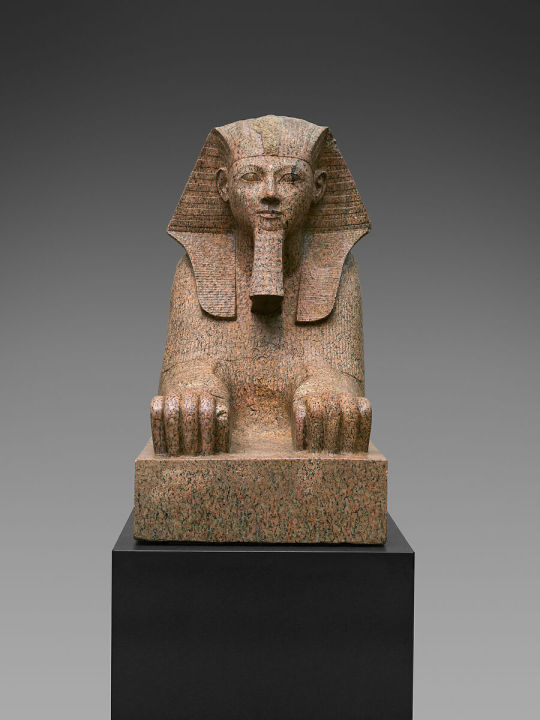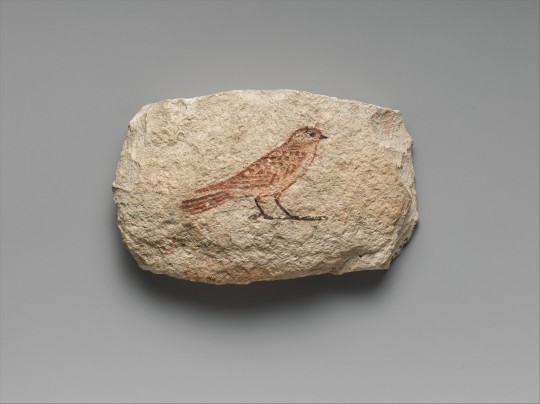#Ca. 1479–1458 B.C
Photo



Sphinx of Hatshepsut
New Kingdom.
Dynasty 18.
Ca. 1479–1458 B.C.
Granite.
H: 164 cm (64 9/16 in.); L: 343 cm (135 1/16 in.); Wt: 6758.6 kg (14900 lb.).
This colossal sphinx portrays the female pharaoh Hatshepsut with the body of a lion and a human head wearing a nemes–headcloth and false beard. The sculptor has carefully observed the powerful muscles of the lion as contrasted to the handsome, idealized face of the pharaoh. It was one of at least six granite sphinxes that stood in Hatshepsut's mortuary temple at Deir el-Bahri.
The Met Fifth Avenue in Gallery 131.
#Sphinx of Hatshepsut#New Kingdom#Dynasty 18#Ca. 1479–1458 B.C#granite sculpture#ancient artifacts#archeology#archeolgst#history#history news#ancient history#ancient culture#ancient civilizations#ancient egypt#egyptian history#egyptian art#the met fifth avenue
298 notes
·
View notes
Text

Artist's Sketch of a Swallow
Egypt, around 1479–1458 B.C.
source
#found by kino#Limestone#Egypt#Metropolitan Museum of Art#Africa#Thebes#Upper Egypt#Ostraka#ca. 1479–1458 B.C.#paint#art history#drawing on a rock#sketch#bird#swallow
40 notes
·
View notes
Text

Artist's Sketch of a Swallow, Thebes, Egypt, ca. 1479-1458 B.C.
14K notes
·
View notes
Text


The Goddess Nekhbet, Temple of Hatshepsut, New Kingdom, ca. 1479-1458 B.C., Charles K. Wilkinson Illustration
Facsimile of a falcon protecting the king, New Kingdom, ca. 1479-1458 B.C., Charles K. Wilkinson Illustration
#charles wilkinson#ancient egypt#egyptian art#egyptology#illustration#illustrator#illustration art#egyptian gods#ancient art#birds#bird art#ancient history#art history#aesthetictumblr#tumblraesthetic#tumblrpic#tumblrpictures#tumblr art#aesthetic#beauty#falcon
246 notes
·
View notes
Photo

Artist’s Sketch of a Swallow
Limestone, Egypt, Metropolitan Museum of Art, Africa, Thebes, Upper Egypt, Ostraka, ca. 1479–1458 B.C.
76 notes
·
View notes
Photo

The Goddess Nekhbet, Temple of Hatshepsut. Facsimile by Charles K. Wilkinson. (ca. 1479-1458 B.C.).
https://www.metmuseum.org/art/collection/search/544559
23 notes
·
View notes
Text

Artist's Gridded Sketch of Senenmut, an important official of Hatshepsut
From Egypt, New Kingdom, ca. 1479–1458 B.C.
In the Met Museum
3 notes
·
View notes
Photo

Hatshepsut’s granite statues were discovered shattered to pieces at Deir el Bahari Hatshepsut (𓇋𓏠𓈖𓎸𓏏𓄂𓏏𓀼𓏪) “imn-ẖnmt ḥA.t-šps.wt” ‘United with Amun, Foremost of Nobel Ladies’ is kneeling in adoration and offering to small jars of oil to the state god 𓊹 “nṯr” and her divine father 𓇋𓏏��� “it” - Amun-Ra 𓇋𓏠𓈖𓇳𓏤 “ı͗mn-rˁ”. The fragments of these statues 𓂙𓏏𓏭𓀾 “ḫnty” were discovered during several seasons of excavations by the Museum’s Egyptian Expedition. The statues were reassembled as much as possible in the field (see attached photographs). Fragments of the statues given to the Metropolitan Museum were reconstructed in New York by attaching them to metal armatures and filling in the gaps with plaster. Although the plaster has been tinted to blend with the stone, it is possible to distinguish the original stone fragments from the plaster fill. Title: Large Kneeling Statue of Hatshepsut Period: New Kingdom Dynasty: Dynasty 18 Reign: Joint reign of Hatshepsut and Thutmose III Date: ca. 1479–1458 B.C. Geography: From Egypt, Upper Egypt, Thebes, Deir el-Bahri, Senenmut Quarry, MMA excavations, 1927–28 Medium: Granite Dimensions: H. 261.5 cm (102 15/16 in.); W. 80 cm (31 1/2 in.); D. 137 cm (53 15/16 in.) 𓋹𓎬𓋹𓎬𓋹𓎬𓋹𓎬𓋹𓎬𓋹𓎬𓋹𓎬𓋹𓎬𓋹𓎬𓋹𓎬𓋹𓎬𓋹𓎬𓋹𓎬𓋹𓎬𓋹𓎬𓋹𓎬𓋹𓎬𓋹𓎬𓋹 📸 1, 3-10 @egyptologylessons 𓋹𓊽𓋴𓆖𓎛𓇳𓎛 © ( 📸 2 @metmuseum and description) 𓊁𓊁𓊁𓊁𓊁𓊁𓊁𓊁𓊁𓊁𓊁𓊁𓊁𓊁𓊁𓊁𓊁𓊁𓊁𓊁 #Ancientegypt #ägypten #egyptianhistory #egyptology #hieroglyphs #egypte #egitto #埃及 #مصر #egipto #이집트 #hatshepsut #statue #deirelbahari #metropolitanmuseumofart #granite (at The Metropolitan Museum of Art, New York) https://www.instagram.com/p/CjaNfmiuPPN/?igshid=NGJjMDIxMWI=
#ancientegypt#ägypten#egyptianhistory#egyptology#hieroglyphs#egypte#egitto#埃及#مصر#egipto#이집트#hatshepsut#statue#deirelbahari#metropolitanmuseumofart#granite
37 notes
·
View notes
Text

Man with a Bow Case and Quiver - Met Museum Collection
Note: This is a modern copy of an original
Inventory Number: 30.4.216
Original Dating: New Kingdom, Dynasty 18, ca. 1479–1458 B.C.
Location Information: Original from Egypt, Upper Egypt, Thebes, el-Khokha, Tomb of Puyemre (TT 39), MMA Graphic Section, 1915
#Man with a Bow Case and Quiver#new kingdom#new kingdom pr#dynasty 18#upper egypt#thebes#el-khokha#el khokha#tomb of puyemre#met museum#30.4.216#mens clothing#NKPRMC
0 notes
Text

Hathor-Head Frieze in the Tomb of Senenmut. Period New Kingdom ~ ca.1479–1458 B.C. Upper Egypt, Thebes. Met Museum
0 notes
Text

Artist’s Sketch of a Swallow, Thebes, Egypt, ca. 1479–1458 B.C. Medium: Limestone.
Dimensions: 6.6 x 10.6 cm.
Collection: Metropolitan Museum of Art, NYC.
From Archaeology & Art
blackramhall: whodunnit, murder mysteries, noir, pulp fiction, italian giallo, detectives and crime, spy stories, serial killers, vintage, manor houses, life and death.
0 notes
Text
Artist's Sketch of a Sparrow.
Depicts a delicate sparrow perched on a slender branch.
The artist has captured the bird's essence with swift, flowing lines, showcasing its small, rounded body and distinctive beak.
The sparrow's feathers are suggested through light, feathery strokes, giving the impression of softness and movement in the breeze.
Its wings are subtly hinted at, slightly folded against its body, conveying a sense of calm and tranquility.
The eye, though simple in its design, exudes a sense of curiosity and liveliness, adding a spark to the otherwise understated sketch.
Overall, the artist has captured the essence of this small bird, portraying its beauty and grace through minimalist yet expressive lines.
Museum excavations, 1922-1923. Acquired in the division of finds, 1923.
Title: Artist's Sketch of a Sparrow
Period: New Kingdom
Dynasty: Dynasty 18
Reign: Joint reign of Hatshepsut and Thutmose III
Date: ca. 1479–1458 B.C.
Geography: From Egypt, Upper Egypt, Thebes, Deir el-Bahri, Hatshepsut Hole, MMA excavations, 1922–23
Medium: Limestone, paint
Dimensions: H. 6.6 cm (2 5/8 in.); W. 10.6 cm (4 3/16 in.); Th. 2.4 cm (15/16 in.)
Credit Line: Rogers Fund, 1923
Accession Number: 23.3.7
Winlock, Herbert E. 1923. "The Egyptian Expedition 1922–1923." In The Metropolitan Museum of Art Bulletin, vol. 18, no. 12, part 2 (December), p. 35, fig. 29.
Oppenheim, Adela 2010. "Sperling." In Falken, Katzen, Krokodile: Tiere im Alten Ägypten: Aus den Sammlungen des Metropolitan Museum of Art, New York, und des Ägyptischen Museums Kairo, edited by Dorothea Arnold. Zurich: Museum Rietberg, p. 82, no. 79.
#edisonmariotti @edisonblog
.br
Esboço artístico de um pardal.
Retrata um delicado pardal empoleirado num galho delgado.

O artista capturou a essência do pássaro com linhas rápidas e fluidas, mostrando seu corpo pequeno e arredondado e seu bico distinto.
As penas do pardal são sugeridas através de pinceladas leves e plumadas, dando a impressão de suavidade e movimento na brisa.
Suas asas são sutilmente insinuadas, levemente dobradas contra o corpo, transmitindo uma sensação de calma e tranquilidade.
O olho, embora simples em seu design, exala uma sensação de curiosidade e vivacidade, adicionando uma faísca ao esboço discreto.
No geral, o artista capturou a essência deste pequeno pássaro, retratando a sua beleza e graça através de linhas minimalistas mas expressivas.
Escavações do museu, 1922-1923. Adquirida na divisão de achados, 1923.
Título: Esboço artístico de um pardal
Período: Novo Reino
Dinastia: Dinastia 18
Reinado: Reinado conjunto de Hatshepsut e Tutmés III
Data: ca. 1479–1458 a.C.
Geografia: Do Egito, Alto Egito, Tebas, Deir el-Bahri, Hatshepsut Hole, escavações MMA, 1922–23
Médio: calcário, tinta
Dimensões: H. 6,6 cm (2 5/8 pol.); L. 10,6 cm (4 3/16 pol.); º. 2,4 cm (15/16 pol.)
Linha de crédito: Fundo Rogers, 1923
Número de Acesso: 23.3.7
Winlock, Herbert E. 1923. "A Expedição Egípcia 1922–1923." No Boletim do Museu Metropolitano de Arte, vol. 18, não. 12, parte 2 (dezembro), p. 35, fig. 29.
Oppenheim, Adela 2010. "Sperling". Em Falken, Katzen, Krokodile: Tiere im Alten Ägypten: Aus den Sammlungen des Metropolitan Museum of Art, Nova York, und des Ägyptischen Museums Kairo, editado por Dorothea Arnold. Zurique: Museu Rietberg, p. 82, não. 79.
1 note
·
View note
Photo

Artist's Sketch of a Swallow, Thebes, Egypt, ca. 1479–1458 B.C.
Limestone, today at Metropolitan Museum of Art, 6.6 x 10.6 cm
Source: Metropolitan Museum of Art / internet archive / public domain
#ostraka#Ancient Egypt#metropolitan museum of art#swallow#africa#limestone#birds#sketch#secular#15th century BC#ok not really a wall painting
12K notes
·
View notes
Text

Offerings, Tomb of Nebamun, New Kingdom, ca. 1479-1458 B.C., Charles K. Wilkinson Illustration
#charles wilkinson#illustration#illustration art#illustrator#ancient egypt#ancient art#ancient history#egyptology#egyptian aesthetic#egyptian art#art history#aesthetictumblr#tumblraesthetic#tumblrpic#tumblrpictures#tumblr art#aesthetic#beauty
44 notes
·
View notes
Photo

~ Hatshepsut statue base.
Period: New Kingdom, 18th Dynasty
Reign: Joint reign of Hatshepsut and Thutmose III
Date: ca. 1479–1458 B.C.
Place of origin: Egypt, Upper Egypt, Thebes, Deir el-Bahri, “Hatshepsut Hole” (depression east of temple of Thutmose III), MMA excavations, 1922–23
Medium: Limestone
528 notes
·
View notes
